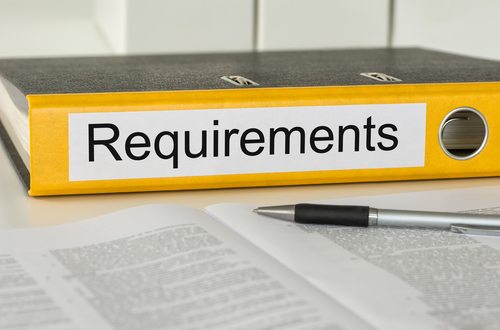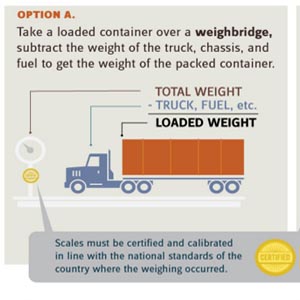VGM FAQ / Weight Verification Requirement
VGM FAQ / Weight Verification Requirement
Sign up for Webinar on this topic @ 1:30 pm on March 9, 2016
For anyone in the global trade industry, it is no surprise there is a delay option on the anticipated SOLAS Verified Gross Mass (VGM) or Weight Verification requirement. This has been an International Maritime Organization topic since 2013. In 2014, The Maritime Safety Committee of the IMO approved guidelines, and the Verified Gross Mass requirement became real in 2015 when the IMO decided on an implementation date for July 1, 2016. With many issues left in a gray area and frustrated parties across the industry, the VGM or Weight Verification requirement continues to be a hot topic. Please use the following guide to answer your questions.
Who created the rule?
The International Maritime Organization (IMO) and the World Shipping Council, trade organizations that represent container liner companies, will require verification of container weights at origin set for July 1, 2016. The amendment created to the International Convention for the Safety of Life at Sea (SOLAS) requires the verified gross mass (VGM) of containers to be documented before they can be loaded on ships. [source]

Photo Source: depositphotos.com/Zerbor
When will the rule go into effect?
July 1, 2016 with the option for the signatory nation to delay implementation for up to one year.
Why the possible delay?
US ports, and ports around the world for that matter, are “ill-prepared for the July implementation of new container weighing requirements.” [source] The Fitch Report mentioned that there are no designated facilities for weighing containers at the ports which could actually lead to extra congestion. On the other hand, many ports do have the technology and engineers that could quickly fix this problem. Most likely the IMO will wait as close to the deadline date to announce their intent to delay implementation to maximize the amount of additional time, as well.
So, how does a nation delay its enforcement date?
As long as the SOLAS signatory nation notifies the U.N. agency prior to July 1, then that nation can delay the requirement with the IMO for up to one year. [source]
The United States Coast Guard said it will not delay the VGM rule, but will also NOT hold shippers responsible for not providing container weight documentation to carriers or penalize them.
Carriers, which for the most part, are foreign-flag ships, will be required to hold shippers responsible for not providing the VGM. How carriers enforce this is not up to the U.S. Coast Guard. [source]
What is the Weight Verification Requirement / Verified Gross Mass VGM rule?
Shippers will be required to declare and verify container weights prior to shipping. If a container is overweight or shippers do not comply with the new regulation, they could face delays, fines, or penalties. This is critical to shippers, as they do not want to incur extra costs, delay a shipment, or upset a customer. [source]
According to JOC, the U.S. Coast Guard states, “Any fiscal punishment for failing to provide a VGM or providing an inaccurate VGM will be in the carriers’ hands. That’s different than Canada’s take, which will level fines on shippers without VGMs.” [source]
The U.S. Coast Guard is now saying it is up to the carrier to confirm that the VGM a shipper declares is accurate and the U.S. Coast Guard agency itself will not be assessing any penalties or fines. [source]
A packed container must be weighed prior to loading the vessel. If the actual gross mass of the container weight is not verified and submitted to the terminal prior to vessel loading, it will not be loaded or at least flagged as “unsafe.” There are two methods to weighing listed below.
How to verify Weight:
Two methods.
Method 1: requires weighing the container, normally when it is empty; then again after loading.
**Bulk cargo such as scrap metal, unbagged grain MUST be weighed by this method.
Method 2: requires weighing the cargo and contents of the container and adding those weights to the tare weight of the container.
Note: No weight estimation allowed.
Under either Method, the weighing equipment used must meet certification and calibration requirements. Further, the party packing the container cannot use the weight somebody else has provided, except in one specific set of defined circumstances.
The one exception is as follows: “Individual, original sealed packages that have the accurate mass of the packages, packing contents and cargo items clearly and permanently marked on their surfaces, do not need to be weighed again when they are packed into the container.” (ex. TV’s that have their weight marked by the manufacturer on the box containing the TV). [source]
Why was the VGM requirement created?
Simply stated, to improve safety. An overweight container can easily damage another shipper’s container, hurt the vessel, cause equipment to be imbalanced, or even hurt the environment.
Who is responsible?
Simply stated, the shipper name listed on the master bill of lading.
Under the IMO Guidelines, “[s]hipper means a legal entity or person named on the bill of lading or sea waybill or equivalent multimodal transport document as shipper and/or a contract of carriage has been concluded with a shipping company.” This responsibility doesn’t go away if a shipper uses a forwarder to pack and weigh a container, forward it to the port and even make the booking with the carrier. If the forwarder is acting purely on the instructions of the shipper to undertake that work on his behalf, and the shipper’s name is still what appears on the bill of lading, it’s the shipper that is responsible for verifying the gross mass weight. The shipper will have to ensure that it’s satisfied with the integrity of the forwarders’ weighing process if it’s relying on the forwarder’s measurement. [source]
The carrier’s responsibility:
“A carrier may rely on a shipper’s signed weight verification to be accurate. The carrier does not need to be a “verifier” of the shipper’s weight verification. Nor do the SOLAS amendments require a carrier to verify that a shipper providing a verified weight according to Method 2 has used a method which has been certified and approved by the competent authority of the jurisdiction in which the packing and sealing of the container was completed. However, it is important to note that, for the shipper’s weight verification to be compliant with the SOLAS requirement, it must be “signed”, meaning a specific person representing the shipper is named and identified as having verified the accuracy of the weight calculation on behalf of the shipper.” [World Shipping Council]
The Coast Guard begs to differ. It stated, “because it’s the carrier that will be the target of enforcement, then it’s up to the carrier to “enforce” the rule on its customers by somehow ensuring that the VGM submitted by the shipper is accurate.” [source] It is fair to say that most likely the controversies and opinions will continue before implementation.

Photo Source: depositphotos.com/lucadp
What is the deadline to supply the VGM to the terminal?
This is still to be determined on an international level. Deadlines will differ according to a number of factors; shippers should obtain information on documentary cut-off times from their carriers in advance of shipment.
How to communicate VGM:
There is no particular form mandated to communicate VGM. However, one person with a first and last name as the signature (not just the company name), must submit information and sign on behalf of the shipper. To read more, click here.
Furthermore, the method of communication for the VGM will be up to the marine terminals among other parties. This is still an area of discussion. In fact, according to the Journal of Commerce, “As of early 2016 there was an effort under way to create a new, standardized electronic shipping document solely for the purpose of conveying the VGM along the supply chain. According to this FAQ published by Hamburg Sud, it will accept a VGM whether in the shipping instructions, booking request, or separately for example in a declaration containing a weight certificate issued by the weighing party, but irrespective of how it is conveyed it must state that it is the VGM and be signed by the representative of the shipper.”
What Scarbrough plans to do for our U.S. export clients:
 As an industry leader in compliance, Scarbrough has already began working with our clients and submitting weight verification. Our truck bill of lading forms are being used as a dual purpose for both a truck bill of lading and a weight verification certificate. Clients fill out these forms, verify the weight, add the container tare weight located on the rear of the container, then designate a person from the company to sign on behalf of the shipper. The forms are then returned to Scarbrough, and Scarbrough submits them to the appropriate party. Scarbrough actually submits these forms on the day of loading, which is well in advance of potential deadlines for VGM submission. If you would like a copy of the form, please email ktaylor@scarbrough-intl.com or call 816.584.2408.
As an industry leader in compliance, Scarbrough has already began working with our clients and submitting weight verification. Our truck bill of lading forms are being used as a dual purpose for both a truck bill of lading and a weight verification certificate. Clients fill out these forms, verify the weight, add the container tare weight located on the rear of the container, then designate a person from the company to sign on behalf of the shipper. The forms are then returned to Scarbrough, and Scarbrough submits them to the appropriate party. Scarbrough actually submits these forms on the day of loading, which is well in advance of potential deadlines for VGM submission. If you would like a copy of the form, please email ktaylor@scarbrough-intl.com or call 816.584.2408.
To learn more, attend our free webinar on March 9, 2016 @ 1:30 pm CST.
Click to Register Now
Click to Submit Questions
Sources:
Journal of Commerce – US won’t delay

